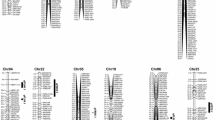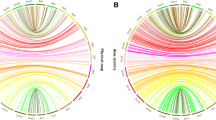Abstract
Because the genetic basis of current upland cotton cultivars is narrow, exploring new germplasm resources and discovering novel alleles relevant to important agronomic traits have become two of the most important themes in the field of cotton research. In this study, G. darwinii Watt, a wild cotton species, was crossed with four upland cotton cultivars with desirable traits. A total of 105 introgression lines (ILs) were successfully obtained. By using 310 mapped SSRs evenly distributed across the interspecific linkage map of G. hirsutum × G. barbadense, these 105 ILs and their corresponding parents were analyzed. A total of 278 polymorphic loci were detected among the 105 ILs, and the average length of introgression segments accumulated to 333.5 cM, accounting for 6.7 % of the whole genome. These lines included many variations. However, high similarity coefficients existed between lines, even between those derived from different parents. Finally, all the ILs and their upland cotton parents were used for association mapping of fiber quality in three environments. A total of 40 SSRs were found to be associated with five fiber quality indexes (P < 0.05) with some being detected in multiple environments and traits. The contribution rate for trait variation was 6.31 % on average, ranging from 2.00 to 14.79 %. This study develops novel ILs for cotton genetics and breeding and provides the basis for future research into fine mapping of genes related to fiber quality, analyses of candidate gene association, and molecular marker-assisted breeding.





Similar content being viewed by others
References
Abdurakhmonov IY, Kohel RJ, Yu JZ (2008) Molecular diversity and association mapping of fiber quality traits in exotic G. hirsutum L. germplasm. Genomics 92:478–487. doi:10.1016/J.YGENO.2008.07.013
Adams DJ, Rolf FJ (2000) Ecological character displacement in Plethodon: biomechanical differences found from a geometric study. Proc Natl Acad Sci USA 97:4106–4111
Ali ML, Paul L, Yu SB, Lorieux M, Eizenga GC (2010) Chromosome segment substitution lines: a powerful tool for the introgression of valuable genes from Oryza wild species into cultivated rice (O. sativa). Rice 3:218–234. doi:10.1007/s12284-010-9058-3
An CF, Jenkins JN, Wu JX, Guo YF, Mccarty JC (2010) Use of fiber and fuzz mutants to detect QTL for yield components, seed, and fiber traits of upland cotton. Euphytica 172:21–34. doi:10.1007/s10681-009-0009-2
Barrero RA, Bellgard M, Zhang XY (2011) Diverse approaches to achieving grain yield in wheat. Funct Integr Genomics 11:37–48. doi:10.1007/s10142-010-0208-x
Benjamini Y, Hochberg Y (1995) Controlling the false discovery rate: a practical and powerful approach to multiple testing. J R Stat Soc Ser C Appl Stat 57(1):289–300
Berloo RV (2008) GGT2.0: Versatile software for visualization and analysis of genetic data. J Hered 99:232–238. doi:10.1093/jhered/esm109
Brubaker CL, Wendel JF (1994) Reevaluating the origin of domesticated cotton (Gossypium hirsutum Malvaceae) using nuclear restriction fragment length polymorphisms (RFLPs). Am J Bot 81:1309–1326
Chen L, Zhang ZS, Hu MC (2008) Genetic linkage map construction and QTL mapping for yield and fiber quality in upland cotton (Gossypium hirsutum L.). Acta Agr Sinica 34:1199–1205. doi:10.3724/sp.j.1006.2008.01199
Chen H, Qian N, Guo WZ, Song QP, Li BC, Deng FJ, Dong CG, Zhang TZ (2009) Using three overlapped RILs to dissect genetically clustered QTL for fiber strength on Chro.D8 in upland cotton. Theor Appl Genet 119:605–612. doi:10.1007/s00122-009-1070-x
He DH, Xing HY, Zhao JX, Li TT, Tang Y, Zeng Z (2011) Population structure inferring and association analysis of fiber quality in cultivated cotton. J Northwest A & F Univ (Nat Sci Ed) 39:103–112
Iqbal MJ, Aziz N, Saeed NA (1997) Genetic diversity evaluation of some elite cotton varieties by RAPD analysis. Theor Appl Genet 94:139–144. doi:10.1007/s001220050392
Jing ZB, Pan DJ, Qu YY, Fan ZL, Chen Y, Chen JY, Chen F, Li C (2008) Application of AB-QTL to exploiting and utilizing the elite genes in wild rice. Mol Plant Breed 6(4):637–644
Li DG, Zhang WY (2004) Study on main economic characters heterosis of upland cotton hybrids F1 generation. J Hubei Agric Coll 24:253–257
Li HH, Zhang LY, Wang JK (2010) Analysis and answers to frequently asked questions in quantitative trait locus mapping. Acta Agro Sinica 36(6):918–931. doi:10.3724/SP.J.1006.2010.00918
Liang ZL (1999) Genetic and breeding science of cotton hybridization. Science Press, Beijing
Lin ZX, He DH, Zhang XL (2005) Linkage map construction and mapping QTL for cotton fiber quality using SRAP, SSR and RAPD. Plant Breed 124:180–187. doi:10.1111/j.1439-0523.2004.01039.x
Liu K, Muse SV (2005) Powermarker: integrated analysis environment for genetic marker data. Bioinformatics 21:2128–2129. doi:10.1093/bioinformatics/bti282
Liu D, Tu L, Wang L (2008) Characterization and expression of plasma and tonoplast membrane aquaporins in elongating cotton fibers. Plant Cell Rep 27:1385–1394. doi:10.1007/s00299-008-0545-6
Nie YC, Zhou XR, Zhang XL (2002) Comparison on yield, pest-resistance and fiber quality of transgenic pest-resistant cotton. Plant Genet Res Sci 3:8–12
Pan JJ (1998) Breeding science for cotton. Agricultural Publishing House of China, Beijing
Park YH, Alabady MS, Ulloa M, Sickler B, Wilkins TA, Yu J, Stelly DM, Kohel RJ, Osama ME, Canrell RG (2005) Genetic mapping of new cotton fiber loci using EST-derived microsatellites in an interspecific recombinant inbred line cotton population. Mol Gen Genomics 274:428–441. doi:10.1007/s00438-005-0037-0
Paterson AH, Brubaker C, Wendel JF (1993) A rapid method for extraction of cotton (Gossypium spp.) genomic DNA suitable for RFLP or PCR analysis. Plant Mol Biol Rep 11:122–127. doi:10.1007/BF02670470
Peakall R, Smouse PE (2006) GENALEX 6: genetic analysis in Excel. Population genetic software for teaching and research. Mol Ecol Notes 6:288–295. doi:10.1111/j.1471-8286.2005.01155.x
Pritchard JK, Stephens M, Donnelly P (2000a) Inference of population structure using multilocus genotype data. Genetics 155:945–959
Pritchard JK, Stephens M, Rosenberg NA, Donnelly P (2000b) Association mapping in structured populations. Am J Hum Genet 67:170–181
Saha S, Wu J, Jenkins JN, McCarty JC, Jr, Gutierrez OA, Stelly DM, Percy RG, Raska DA (2004) Effect of chromosome substitutions from Gossypium barbadense L. 3-79 into G. hirsutum L. TM-1 on agronomic and fiber traits. J Cotton Sci 8:162–169
Septiningsih EM, Prasetiyono J, Lubis E, Tai TH, Tjubaryat T, Moeljopawiro S, McCouch SR (2003) Identification of quantitative trait loci for yield and yield components in an advanced backcross population derived from the Oryza sativa variety IR64 and the wild relative O. rufipogon. Theor Appl Genet 107(8):1419–1432
Shen XL, Guo WZ, Zhu XF, Yuan YL, Yu ZJ, Kohel RJ, Zhang TZ (2005) Molecular mapping of QTLs for fiber qualities in three diverse lines in upland cotton using SSR markers. Mol Breed 15:169–181. doi:10.1007/S11032-004-4731-0
Takershi E, Yoshinobu T, Yasunori N, Toshio Y, Kasumi T, Masahiro Y (2005) Construction and evaluation of chromosome segment substitution lines carrying overlapping chromosome segments of indica rice cultivar ‘Kasalath’ in a genetic background of japonica elite cultivar ‘Kooshihikari’. Breed Sci 55:65–73
Tanksley SD, Nelson JC (1996) Advanced backcross QTL analysis: a method for the simultaneous discovery and transfer of valuable QTLs from unadapted germplasm into elite breeding lines. Theor Appl Genet 92(2):191–203
Thomson MJ, Tai TH, McClung AM, Hinga ME, Lobos KB, Xu Y, Martinez C, McCouch SR (2003) Mapping quantitative trait loci for yield, yield components, and morphological traits in an advanced backcross population between Oryza rufipogon and the Oryza sativa cultivar Jefferson. Theor Appl Genet 107(3):479–493
Wang P, Ding YZ, Lu QX, Guo WZ, Zhang TZ (2008) Development of Gossypium barbadense chromosome segment substitution lines in the genetic standard line TM-1 of Gossypium hirsutum. Chin Sci Bull 53:1512–1517. doi:10.1007/s11434-008-0220-x
Yang ZM, Li JZ, Li AG, Zhang BC, Liu GP, Li JW, Shi YZ, Liu AY, Jiang JX, Wang T, Yuan YL (2009) Developing chromosome segment substitution lines (CSSLs) in cotton (Gossypium) using advanced backcross and MAS. Mol Plant Breed 7:233–241
Ye GY, Liang SS, Wan JM (2010) QTL mapping of protein content in rice using single chromosome segment substitution lines. Theor Appl Genet 121:741–750. doi:10.1007/s00122-010-1345-2
Yu J, Pressoir G, Briggs WH, Bi IV, Yamasaki M, Doebley JF, McMullen MD, Gaut BS, Nielsen DM, Holland JB, Kresovich S, Buckler ES (2006) A unified mixed-model method for association mapping that accounts for multiple levels of relatedness. Nat Genet 38:203–208
Zhang YX, Lin ZX, Xia QZ, Zhang XL (2008) Characteristics and analysis of simple sequence repeats in the cotton genome based on a linkage map constructed from a BC1 population between Gossypium hirsutum and G. barbadense. Genome 51:534–546. doi:10.1139/G08-033
Zhang ZS, Hu MC, Zhang J (2009) Construction of a comprehensive PCR-based marker linkage map and QTL mapping for fiber quality traits in upland cotton (Gossypium hirsutum L.). Mol Breed 24:49–61. doi:10.1007/s11032-009-9271-1
Zhang K, Zhang J, Ma J, Tang SY, Liu DJ, Teng ZH, Liu DX, Zhang ZS (2010) Genetic mapping and quantitative trait locus analysis of fiber quality traits using a three-parent composite population in upland cotton (Gossypium hirsutum L.). Mol Breed. doi:10.1007/s11032-011-9549-y
Zhao LN, Zhou HJ, Lu LX, Liu L, Li XH, Lin YJ, Yu SB (2009) Identification of quantitative trait loci controlling rice mature seed cultivability chromosomal segment substitution lines. Plant Cell Rep 28:247–256. doi:10.1007/s00299-008-0641-7
Zhu WY, Lin J, Yang DW, Zhao L, Zhang YD, Zhu Z, Chen T, Wang CL (2009) Development of chromosome segment substitution lines derived from backcross between two sequenced rice cultivars, Indica recipient 93–11 and Japonica donor Nipponbare. Pant Mol Biol Rep 27:126–131. doi:10.1007/s11105-008-0054-3
Acknowledgments
This work was financially supported by the National Basic Research Program (No. 2011CB109303) and Genetically Modified Organisms Breeding Major Project of China (No. 2008ZX08009-001).
Author information
Authors and Affiliations
Corresponding author
Additional information
Communicated by M. Frisch.
Electronic supplementary material
Below is the link to the electronic supplementary material.
Rights and permissions
About this article
Cite this article
Wang, B., Nie, Y., Lin, Z. et al. Molecular diversity, genomic constitution, and QTL mapping of fiber quality by mapped SSRs in introgression lines derived from Gossypium hirsutum × G. darwinii Watt. Theor Appl Genet 125, 1263–1274 (2012). https://doi.org/10.1007/s00122-012-1911-x
Received:
Accepted:
Published:
Issue Date:
DOI: https://doi.org/10.1007/s00122-012-1911-x




